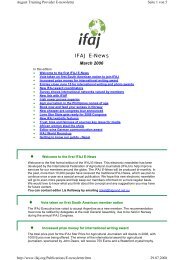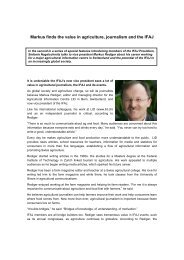Sweden! - International Federation of Agricultural Journalists
Sweden! - International Federation of Agricultural Journalists
Sweden! - International Federation of Agricultural Journalists
Create successful ePaper yourself
Turn your PDF publications into a flip-book with our unique Google optimized e-Paper software.
40 SOLUTIONS FOR A GREEN FUTURE<br />
Renewable energy<br />
power, but it can sometimes be difficult<br />
to get permission from the authorities<br />
because <strong>of</strong>, for example, neighbours. There<br />
is also wind power in forest areas and wind<br />
parks in the seas around <strong>Sweden</strong>.<br />
Forest fuel gives forest owners pr<strong>of</strong>its<br />
<strong>Sweden</strong> is covered by a lot <strong>of</strong> forest. When<br />
forest owners harvest the trees, the thick<br />
part <strong>of</strong> the trunk is sent to sawmills to be<br />
turned into planks and boards. The thin<br />
end <strong>of</strong> the trunks goes to pulp mills and<br />
becomes paper. The tops and the branches<br />
used to be left in the forest for the harvest<br />
machines to drive over and use as fertilizer<br />
for the soil. However, today it is becoming<br />
more and more common to gather the<br />
tops and branches and leave them to dry<br />
in stacks. The material is then chipped and<br />
burned in power plants. Over the last few<br />
years, the selling <strong>of</strong> tops and branches has<br />
started to give a modest pr<strong>of</strong>it to the forest<br />
owners.<br />
Pellets and straw<br />
Some <strong>of</strong> the sawdust that is automatically<br />
produced in sawmills is used to make<br />
pellets, which many private persons and<br />
farmers use to heat their houses. Pellets are<br />
also used in power plants. Some farmers<br />
heat their buildings by burning straw.<br />
Stumps have potential<br />
Even stumps, the roots <strong>of</strong> trees, have<br />
started to be used for fuel in power plants.<br />
So far, the technique is not very developed.<br />
Therefore, only small areas are harvested<br />
by forest companies. There is a lot <strong>of</strong> energy<br />
in stumps and that is why the harvesting<br />
<strong>of</strong> stumps will probably become more<br />
common.<br />
Energy crops<br />
Farmers can grow, for example, energy<br />
forests like willow for fuel in power plants<br />
and grains for the production <strong>of</strong> ethanol.<br />
In 2010, willow was grown on around<br />
13,000 hectares <strong>of</strong> land. It is <strong>of</strong>ten land <strong>of</strong><br />
low quality that is used for growing willow,<br />
not good farmland. The large farmers’<br />
cooperative Lantmännen owns, among<br />
other things, the company Agroetanol,<br />
which uses around 550,000 tons <strong>of</strong> grains<br />
to produce 210 million litres <strong>of</strong> ethanol per<br />
year. There are numerous kinds <strong>of</strong> financial<br />
support that farmers receive for growing or<br />
otherwise investing in energy crops.<br />
Biogas from the farm<br />
Biogas is produced both on a small scale<br />
by single farms and on a large scale by<br />
companies. Farmers use manure and parts<br />
<strong>of</strong> plants to make biogas to power their<br />
farms. Groups <strong>of</strong> farmers produce biogas<br />
that is used for heating buildings in local<br />
communities. Biogas is also used to power<br />
vehicles. About 1.5 terawatt hours <strong>of</strong> biogas<br />
is produced in <strong>Sweden</strong> every year. 4










